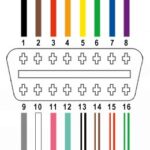Maintaining a vehicle fleet involves staying ahead of potential issues. Diagnostic Trouble Codes (DTCs), generated by a vehicle’s onboard diagnostic (OBD) system, play a crucial role in this process. Understanding these codes, particularly what “1 as first digit in OBD2” signifies, is essential for effective fleet management.
OBD-II, the standard for light and medium-duty vehicles in the US since 1996, utilizes a five-character code system to pinpoint specific vehicle problems. Each character provides unique information, starting with the first digit which categorizes the system experiencing the malfunction. This article delves into the meaning of a “1” as the first digit in OBD2 codes and its implications.
Decoding the First Digit: “1” in OBD2 Codes
The first character in an OBD2 code is always a letter, indicating the affected system:
- P: Powertrain (engine, transmission, fuel system)
- B: Body (components within the passenger compartment)
- C: Chassis (mechanical systems outside the passenger compartment)
- U: Network & Vehicle Integration (communication systems)
However, a numeric “1” as the first digit often signifies a manufacturer-specific code. This deviates from the standard OBD-II codes (which start with P, B, C, or U) and indicates a problem defined by the vehicle’s manufacturer.
Why “1” Matters: Manufacturer-Specific Codes
Encountering a “1” as the first digit means the code’s interpretation requires consulting the vehicle manufacturer’s documentation. These enhanced codes provide more granular diagnostics specific to the make and model, addressing issues beyond the scope of standardized OBD-II codes.
This distinction is critical because generic OBD-II scanners might not decipher these codes accurately. Specialized tools or access to manufacturer databases are often necessary to understand the precise issue.
Practical Implications for Fleet Management
For fleet managers, a “1” as the first digit presents unique challenges:
- Diagnosis Difficulty: Requires manufacturer-specific resources for accurate interpretation.
- Varied Tools: May necessitate specialized diagnostic equipment beyond generic OBD-II scanners.
- Maintenance Complexity: Potentially more involved repairs due to the unique nature of the problem.
Utilizing Telematics for Enhanced Diagnostics
Telematics systems offer a solution to the challenges posed by manufacturer-specific codes. Advanced telematics solutions can integrate with various vehicle systems, including manufacturer-specific diagnostics, providing comprehensive insights into fleet health. These systems can translate complex codes, provide real-time alerts, and streamline maintenance processes.
Conclusion: Navigating the Complexity of OBD2 Codes
Understanding the significance of “1 as first digit in OBD2” is crucial for efficient vehicle maintenance and fleet management. While standardized codes offer a broad overview, manufacturer-specific codes provide critical details for accurate diagnosis. Leveraging advanced telematics solutions allows fleet managers to navigate the complexities of these codes, optimizing vehicle uptime and minimizing operational disruptions.

